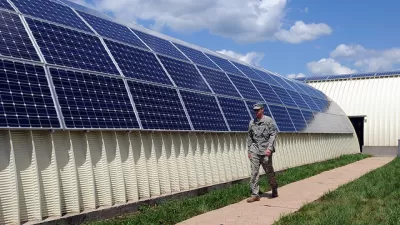Two western states had very similar renewable energy initiatives on the ballot sponsored by NextGen America requiring utilities to get 50 percent of electricity by 2030. It passed in Nevada but was rejected in Arizona.

"Voters overwhelmingly rejected Proposition 127, a ballot measure that would force electric companies to get half of their energy from renewable sources by 2030, the Associated Press projected Tuesday night," report Ryan Randazzo for the Arizona Republic.
California billionaire activist Tom Steyer's political group NextGen America spent heavily to get the measure on the ballot and win over voters, but Steyer was outspent by Arizona Public Service Co. [the largest electric utility in Arizona] and other opponents of the measure.
It easily was the most expensive ballot measure in state history.
It will now be up to the Arizona Corporation Commission, five elected officials who regulate utility rates and policies, to increase the renewable requirement from the current renewable portfolio standard of 15 percent by 2025. Randazzo indicates that the commission is "considering an increase in that standard to get 80 percent of the state's electricity from renewables and nuclear energy by 2050."
Nevada – energy monopoly initiative takes center stage
Clean energy advocates hailed the outcome not only of Question 6, which received nearly 60 percent of vote, and like Arizona Prop. 127, requires utilities to obtain half of their electricity from renewable sources by 2030, but also Question 3, which would challenge the dominance of NV Energy, a Berkshire Hathaway subsidiary providing 90 percent of Nevada's electricity, and allow consumers to pick their own power provider by 2023.
While it's clear why the four clean energy advocacy groups, Southwest Energy Efficiency Project, Western Resource Advocates, Natural Resources Defense Council, and the Sierra Club, would support the renewable energy initiative, additional explanation is needed to explain why they would oppose ending the power monopoly.
The groups argued that the measure, which would "prohibit state-sanctioned electric-generation monopolies" and create a deregulated market, "would interrupt NV Energy’s commitment to double its current level of renewable energy generation by 2023, call into question the future of utility-sponsored energy efficiency programs, and introduce uncertainty into the state’s recovering rooftop solar industry," according to a July 26 press release. The Silver State has a renewable portfolio standard requirement to reach 25 percent by 2025.
Question 3, not the renewable energy mandate, was "one of the most heavily financed political battles in the U.S. election cycle" with almost $100 million spent, according to Bloomberg News.
James DeHaven of the Reno Gazette Journal reports that [a]bout two in three poll-goers rejected the proposed state constitutional amendment, completing almost a 180-degree flip from 2016, when nearly three-quarters of voters approved of the measure." According to Ballotpedia, initiated constitutional amendments in Nevada need to be approved at two successive general elections.
NV Energy, backed by famed billionaire investor Warren Buffett, spent $63 million convincing Nevadans to change their minds.
Measure backers, among them casino mogul Sheldon Adelson, spent $21 million defending the initiative. It wasn’t enough to bounce back from the loss of several high-profile political endorsements, as well as opposition from many of the state’s environmental and organized labor groups.
Additional information on NextGen's political campaign to increase the use of renewable energy, including a success in Michigan, can be found in last month's post, "Arizona and Nevada to Vote on Renewable Energy Initiatives."
FULL STORY: Arizona voters reject clean-energy measure Proposition 127 by large margin

Planetizen Federal Action Tracker
A weekly monitor of how Trump’s orders and actions are impacting planners and planning in America.

DARTSpace Platform Streamlines Dallas TOD Application Process
The Dallas transit agency hopes a shorter permitting timeline will boost transit-oriented development around rail stations.

Congressman Proposes Bill to Rename DC Metro “Trump Train”
The Make Autorail Great Again Act would withhold federal funding to the system until the Washington Metropolitan Area Transit Authority (WMATA), rebrands as the Washington Metropolitan Authority for Greater Access (WMAGA).

Supreme Court Ruling in Pipeline Case Guts Federal Environmental Law
The decision limits the scope of a federal law that mandates extensive environmental impact reviews of energy, infrastructure, and transportation projects.

Texas State Bills to Defund Dallas Transit Die
DART would have seen a 30% service cut, $230M annual losses had the bills survived.

Bikeshare for the Win: Team Pedals to London Cricket Match, Beats Rivals Stuck in Traffic
While their opponents sat in gridlock, England's national cricket team hopped Lime bikes, riding to a 3-0 victory.
Urban Design for Planners 1: Software Tools
This six-course series explores essential urban design concepts using open source software and equips planners with the tools they need to participate fully in the urban design process.
Planning for Universal Design
Learn the tools for implementing Universal Design in planning regulations.
Roanoke Valley-Alleghany Regional Commission
City of Mt Shasta
City of Camden Redevelopment Agency
City of Astoria
Transportation Research & Education Center (TREC) at Portland State University
US High Speed Rail Association
City of Camden Redevelopment Agency
Municipality of Princeton (NJ)




























